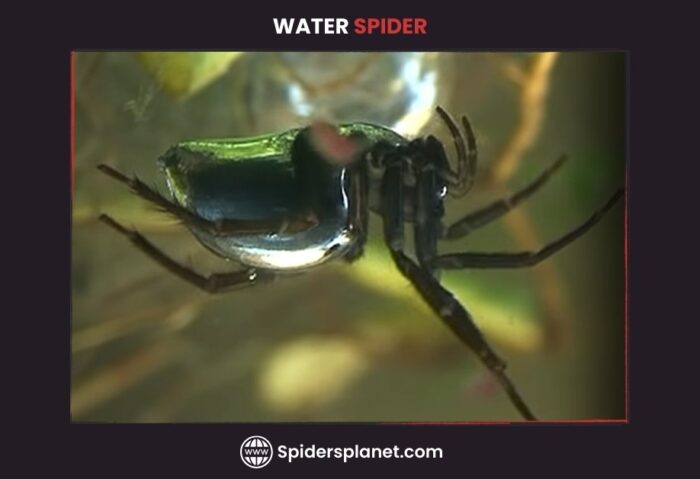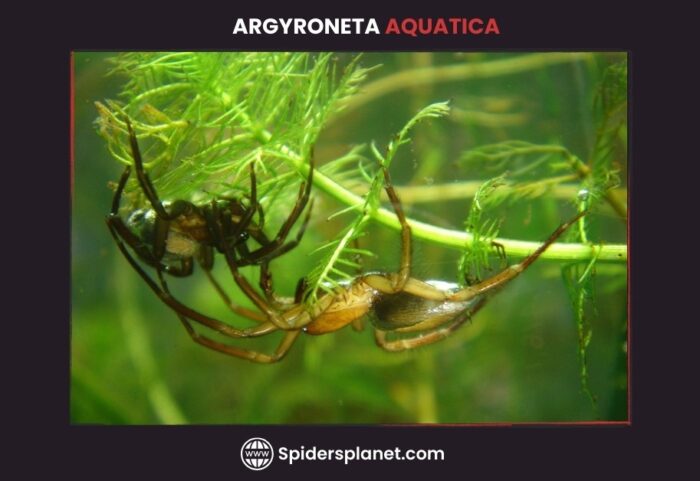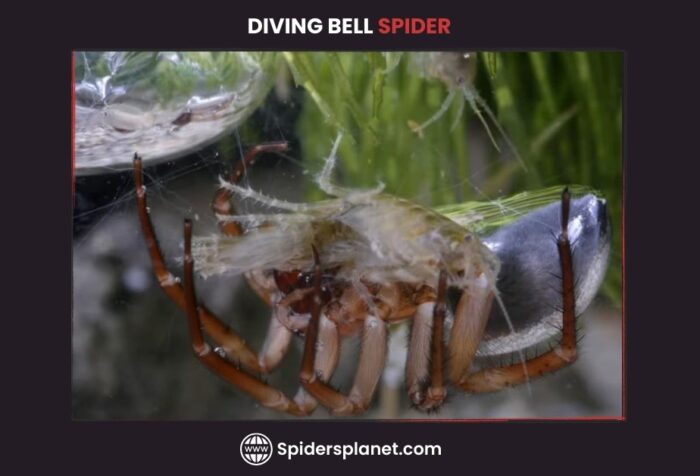The diving bell spider or Water spider is an underwater architect with eight legs. Instead of webs, it crafts an air bubble under the pond’s surface, creating a shimmering dome.
This bubble serves as its home, where it breathes, hunts, and raises its young. The spider, a tiny builder, uses its hairy abdomen to scoop and weave miniature air bubbles into the dome.
This underwater haven also doubles as a clever hunting trap, capturing prey with silken threads.
The water spider’s story showcases resilience and resourcefulness. Isn’t it interesting? And you want to know more about its appearance, habits and habitat, anatomy, bite, food, and life cycle, or its facts.
Here in this article I am going to tell you all about this little wonder hiding just below the surface in our watery world. Keep reading…!
Diving Bell Spider or Water Spider Description:
Scientific Name, Specie, and Family:
The Diving bell spider or Water spider, scientifically named Argyroneta aquatica, belongs to the kingdom Animalia, within the family Dictynidae, and is identified by the genus Argyroneta.
Its precise binomial name, Argyroneta aquatica, reflects its distinctive aquatic lifestyle, highlighting its ability to thrive underwater throughout its entire life.

The diving bell spider is a single species known as Argyroneta aquatica, and there are no distinct variations or different types within this species.
The genus name Argyroneta originates from the Greek words “Argyros” (meaning “silver”) and “neta,” a term possibly derived from “neo” (meaning “spin”).
Together, Argyroneta translates to “spinner of silver,” aptly describing the water spider’s silvery appearance and its skill in crafting underwater webs.
Body / Anatomy:
The head of the spider thorax, called the cephalothorax, holds eight eyes, fangs, and legs.
Females have shorter front legs than males. The abdomen, covered in water-resistant hairs, houses important organs and acts like a floaty suit by trapping air bubbles.
Instead of using book lungs for breathing underwater, the spider relies on an air bubble in its diving bell, which it refreshes by going to the water’s surface.
The spider’s sharp fangs inject venom into prey, and its legs, covered in hairs, help it feel vibrations and move in water.
The water-resistant hairs on its body reduce drag, and the spider uses silk not only for its diving bell but also for wrapping up prey and making egg sacs underwater.
While the spider’s eight eyes are not great for seeing underwater, they can sense changes in light and shadow to help it navigate.
Appearance: How to Identify?
Size:
The water spider is relatively small in size. Females typically range from 7.8 to 13.1 millimeters in body length, while males are slightly larger, measuring between 7.8 to 18.7 millimeters.

Their leg spans can reach up to 26 millimeters for males and 17 millimeters for females. Notably, males are larger than females, an unusual feature compared to most spiders.
Color:
In terms of color, the spiders appear silvery underwater due to the air bubble around them, creating an otherworldly effect.
Out of the water, they reveal a brownish-black color with a velvety look on the abdomen and a brown cephalothorax.
While there may be minor variations in size and color depending on location and individual characteristics, these differences are subtle and do not significantly impact the spider’s overall appearance.
Related Article: Antilles Pinktoe Tarantula: A Caribbean Jewel That Crawls
How Do They Breath?
They have a special air bubble in their silky homes, brought down from the water’s surface by the spider’s furry abdomen, acting like a scuba suit.
Not only that, but the spider’s body also lets it “breathe” through its skin, pulling in oxygen from the water. To keep things just right, the spider takes trips to the surface, bringing down fresh air.
It’s like a dance between going up for air and staying down to enjoy their watery world.
What They Like to Eat?
The water spider has a taste for a variety of small water critters. Its main prey include mosquito larvae, daphnia (tiny aquatic creatures), small crustaceans, water mites, mayfly nymphs, and phantom midge larvae.

These little aquatic insects make up the spider’s primary menu, showcasing its skill in hunting and capturing a diverse range of underwater delicacies.
Habitat and Adaptation:
The Argyroneta aquatica lives in clean, freshwater homes filled with watery plants.
These habitats include lakes, ponds, canals, marshes, and gentle-flowing streams. The Water spider can be found in different parts of Europe, the British Isles, Central and Nothern Asia, and even in some parts of Iran and Siberia as well.
The main kind of Argyroneta aquatica lives across this wide area, but Japan has its own slightly different kind called A. japonica. However, you won’t spot them in Portugal, Greece, or Albania.
Diving bell spiders are like underwater home designers. They spin a bell-shaped web, a bit like a cozy room, where they live most of the time.
When they step out, it is for important tasks like catching food, finding a friend, or getting more air for the bubble on their fuzzy belly. It is like a little spider world where they have their own special space!
Behavior and Hunting:
It uses silk to build this cozy place, anchored to underwater spots and fills it with air bubbles. This bubble not only helps them breathe but also works as a smart trap for catching small underwater creatures.
The spider, with its eight legs, is a clever hunter, moving beyond its bubble to catch prey.
Even though they usually live alone, during mating time, males build smaller homes close to females.
The female takes care of her eggs in her home until baby spiders are ready to explore. The spider also takes short trips to the water’s surface to keep its bubble full of fresh air, making sure it stays comfy in its underwater world.
Lifecycle and Reproduction:
During their mating season, male spiders, slightly larger and with longer legs, construct smaller diving bells near female domains.
They show a delicate courtship dance, showcasing hunting skills, and if deemed worthy, the male enters the female’s bell for fertilization.
Following successful mating, the female places her eggs within a silken sac containing around 30-70 eggs, guarded by the female in her diving bell, creating a secure nursery for its spiderlings.
Young spiders, or hatchlings, are under the close observation and care of their mother.
During this period, they learn survival skills, including how to construct webs and hunt for food.
As spiderlings grow, they leave the maternal bell, venturing out to create their own underwater homes and continue the cycle.
The underwater family tale encompasses a protective mother, tiny, vulnerable hatchlings, and independent explorers, ensuring the continuation of this intriguing water spider species.
Lifespan:
In captivity, the average duration of a Argyroneta aquatica’s life is approximately two years.
This is quite impressive, considering their relatively small size and aquatic lifestyle. In their natural habitat, it may be shorter due to the potential for predation and environmental challenges.
Predators:
Larger fish, like perch and bass, can break into their homes, while frogs, with their diving skills, snatch spiders outside their protective bubbles.
Even larger insects, such as dragonflies, pose a danger despite the spiders’ silk defenses. Though rare, competition and potential predation from other diving spiders add complexity to their aquatic existence.
Bite and Venom:
Though some old resources have shown that the bite of this spider can leave humans in pain for a few days (lack of evidence), the water spider does not pose any known risk to humans.
Its venom lacks the potency to cause significant harm, and its small fangs are capable of piercing human skin.
Whether it’s venomous or not is not yet identified, but it is not dangerous for humans except for a painful bite.
Moreover, the spider’s solitary behavior and underwater habitat make encounters with people highly improbable.
This combination of harmless venom, small fangs, and the spider’s natural behavior ensures a safe coexistence with humans, minimizing any potential risks.
Also Read: King Baboon Spider: Intro, Habitat, Looks, Diet & Life Cycle
Interesting Facts About Diving Bell Spider:
- Argyroneta aquatica sustain themselves underwater by utilizing a dome-shaped air bubble on their abdomen for breathing.
- They do not spin traditional webs but craft shimmering air bubbles as their homes, using their hairy abdomen to trap air like tiny scuba suits.
- Their silk dome doubles as a clever trap, luring unsuspecting prey like insect larvae.
- While they typically spend their lives alone, during mating season, male spiders woo females with a delicate courtship dance of web vibrations and hunting prowess.
- Females lay around 30-70 eggs in a silken sac within their bubble, carefully guarding and nurturing their spiderlings until they are ready to venture out and build their own underwater castles.
- Their eight eyes are not equipped for underwater vision.
- To keep their bubbly homes fresh, they make regular trips to the surface, capturing new air pockets with their hairy abdomens, a miniature act of air piracy.
- These tiny architects can live for up to two years in captivity.
- Their bite is painful but poses no threat to humans.
- The Argyroneta aquatica stands out as a unique arachnid with the remarkable ability to live and breathe entirely underwater without the risk of drowning, distinguishing it from most other spiders.
FAQs:
Can we keep Diving Bell Spider as a pet?
Keeping diving bell spiders as pets are discouraged due to challenges in recreating their natural habitat, maintaining the vital air bubble, and providing suitable prey in captivity.
The solitary nature of these spiders can lead to stress in confined spaces, impacting their well-being and natural behaviors.
Ethical concerns arise from disrupting ecosystems by capturing them from the wild. Instead of ownership, observing Argyroneta aquatica in nature or through educational resources is recommended.
How many eyes does a Diving bell spider have?
The Diving bell or Argyroneta aquatica has eight eyes.
How long can a Diving bell survive underwater?
In captivity, the average lifespan of the Diving bell is up to 2 years.
Are Water spiders endangered?
Not listed as endangered, but vulnerable to habitat loss and pollution.
How does a Diving bell spider catch its food?
The diving bell employs a hunting strategy where it first lures its prey into a silk web that it has constructed.
Once the prey is hunted, the spider injects venom into it. This venom serves to immobilize and begin the digestion of the prey, turning it into a more easily consumable form for the spider.
Is the Water spider poisonous?
Venomous but only potent for tiny prey, no threat to humans.




Leave a Reply